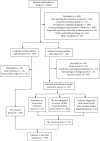Score for Predicting Active Cancer in Patients with Ischemic Stroke: A Retrospective Study
- PMID: 34124248
- PMCID: PMC8169246
- DOI: 10.1155/2021/5585206
Score for Predicting Active Cancer in Patients with Ischemic Stroke: A Retrospective Study
Abstract
Background: We aimed to examine the differences of clinical characteristics between patients with ischemic stroke with active cancer and those without cancer to develop a clinical score for predicting the presence of occult cancer in patients with ischemic stroke.
Methods: This retrospective study enrolled consecutive adult patients with acute ischemic stroke who were admitted to our department between December 2017 and January 2019. The demographic, clinical, laboratory, and neuroimaging characteristics were compared between patients with ischemic stroke with active cancer and those without cancer. Multivariate analysis was performed to identify independent factors associated with active cancer. Subsequently, a predictive score was developed using the areas under the receiver operating characteristic curves based on these independent factors. Finally, Bayesian decision theory was applied to calculate the posterior probability of active cancer for finding the best scoring system.
Results: Fifty-three (6.63%) of 799 patients with ischemic stroke had active cancer. The absence of a history of hyperlipidemia (odds ratio (OR) = 0.17, 95% confidence interval (CI): 0.06-0.48, P < 0.01), elevated serum fibrinogen (OR = 1.72, 95% CI: 1.33-2.22, P < 0.01) and D-dimer levels (OR = 1.43, 95% CI: 1.24-1.64, P <0.01), and stroke of undetermined etiology (OR = 22.87, 95% CI: 9.91-52.78, P < 0.01) were independently associated with active cancer. A clinical score based on the absence of hyperlipidemia, serum fibrinogen level of ≥4.00 g/L, and D-dimer level of ≥2.00 μg/mL predicted active cancer with an area under the curve of 0.83 (95% CI: 0.77-0.89, P < 0.01). The probability of active cancer was 59% at a supposed prevalence of 6.63%, if all three independent factors were present in a patient with ischemic stroke.
Conclusions: We devised a clinical score to predict active cancer in patients with ischemic stroke based on the absence of a history of hyperlipidemia and elevated serum D-dimer and fibrinogen levels. The use of this score may allow for early intervention. Further research is needed to confirm the implementation of this score in clinical settings.
Copyright © 2021 Jiwei Jiang et al.
Conflict of interest statement
The authors have no competing interests to declare.
Figures


References
MeSH terms
Substances
LinkOut - more resources
Full Text Sources
Medical

